 Artist's conception of the Mars Climate Orbiter | |
| Names | Mars Surveyor '98 Orbiter |
|---|---|
| Mission type | Mars orbiter |
| Operator | NASA/JPL |
| COSPAR ID | 1998-073A |
| SATCAT no. | 25571 |
| Website | science.nasa.gov |
| Mission duration | 286 days Mission failure |
| Spacecraft properties | |
| Manufacturer | Lockheed Martin |
| Launch mass | 638 kilograms (1407 lb)[1] |
| Power | 500 watts |
| Start of mission | |
| Launch date | December 11, 1998, 18:45:51 UTC |
| Rocket | Delta II 7425 D-264 |
| Launch site | CCAFS SLC-17A |
| Contractor | Boeing |
| End of mission | |
| Disposal | Destroyed |
| Last contact | 23 September 1999 09:06:00 UTC Unintentionally deorbited |
| Orbital parameters | |
| Reference system | Areocentric |
| Epoch | Planned |
 Mars Surveyor 98 mission logo | |
The Mars Climate Orbiter (formerly the Mars Surveyor '98 Orbiter) was a robotic space probe launched by NASA on December 11, 1998, to study the Martian climate, Martian atmosphere, and surface changes and to act as the communications relay in the Mars Surveyor '98 program for Mars Polar Lander. However, on September 23, 1999, communication with the spacecraft was permanently lost as it went into orbital insertion. The spacecraft encountered Mars on a trajectory that brought it too close to the planet, and it was either destroyed in the atmosphere or escaped the planet's vicinity and entered an orbit around the Sun.[2] An investigation attributed the failure to a measurement mismatch between two measurement systems: SI units (metric) by NASA and US customary units by spacecraft builder Lockheed Martin.[3]